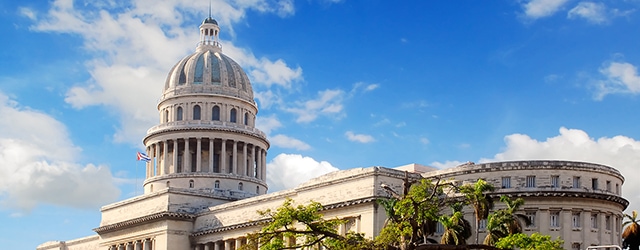As Cuba becomes more capital-friendly, tensions with the US are unnerving investors.

|
CUBA: VITAL STATISTICS |
|---|
|
Location: Central America |
|
Neighbors: United States, Bahamas, Turks and Caicos, Haiti, Jamaica, Cayman Islands, Mexico |
|
Capital city: Havana |
|
Population (2019): 11,490,125 |
|
Official language: Spanish |
|
GDP per capita (2015): US$8,433, up 5.9% |
|
GDP growth (2018): 1.2% |
|
Inflation (2018): 5.9% |
|
Currency: peso (CUP) and convertible peso (CUC) |
|
Investment promotion agency: ProCuba |
|
Investment incentives available? High tax breaks in the Mariel Zone |
|
Ease of Doing Business rank: Not ranked |
|
Corruption Perceptions Index rank (2017): 81 |
|
Political risks: Growing spat with US over support for Venezuela raising specter of new sanctions; uncertainty about transition to younger generation of leaders; possibility of social unrest if economic reforms fail to boost living standards |
|
Security risks: Car-related crime and muggings occur from time to time; pickpockets and bag-snatchers |
|
PROS |
|---|
|
No terrorism |
|
New constitutional amendment expected to usher in a more pro-business regime and FDI |
|
Nascent tourism industry |
|
Government plans to end complicated dual-currency system |
|
CONS |
|---|
|
Difficult to assess risks |
|
Serious liquidity problems |
|
Cuban economy remains weak |
|
Merchandise trade deficit strains the country’s finances |
|
Companies do not hire or pay workers directly but must work through a government agency |
|
Very complex approval process |
|
Unresolved issues over Fidel Castro’s nationalization of American properties |
|
Sources: Economist Intelligence Unit, Knoema.com, Prensa Latina, Reuters, Transparency International, UK government, US State Department, World Bank, World Population Review, Trading Economics |
|
For more information, check out Global Finance‘s Cuba Economic Report data page. |
Cuba recently approved a referendum to transition to a more investment-friendly economy, but it is unlikely to woo more from foreign investors at the moment.
In response to the Communist island’s support for Venezuelan leader Nicolás Maduro, the US is stepping up sanctions. In March, the White House announced it will allow US citizens (including those of Cuban origin) to sue foreign companies and individuals under the Helms-Burton Act to recover property seized during the Cuban Revolution. Cuban Foreign Minister Bruno Rodríguez branded the move “political blackmail” and a “brutal attack against international law.”
The new twist in the 60-year standoff between Washington and Havana “makes the outlook extremely uncertain” for foreign investment, says David Jessop, a Cuba expert for Caribbean Council. With the US toughening penalties against US-owned international companies operating on the island (e.g. the recent $5.5 million penalty against German-based AppliChem, owned by Illinois Tool Works), investors are spooked.
“Risks have become harder to assess,” Jessop explains. “Companies and financial institutions are very concerned about the risk of touching the US financial system.”
The new reality will make it harder for Havana to meet its goal of luring $2 billion annually in foreign direct investment (FDI). Even when investment spiked as Obama pushed normalization, Cuba missed that target. And despite recent moves to diversify the investor base by approaching Nigeria and Qatar, on top of moves to entice Russian, Chinese and Spanish capital, interest has ebbed, Jessop says: “It strikes me that there have been no investments in the last two months.”
China eyed investments in the new Mariel Special Development Zone (ZEDM), particularly relating to new hotel projects; but those plans appear to have lost steam, observers say. So far, Spanish investors have been the biggest international players in the ZEDM, which has attracted $474 million so far, according to government officials.
Cuba attracted $1.5 billion in FDI through 40 new business deals last year, according to Foreign Trade and Investment Minister Rodrigo Malmierca.
The Havana International Fair last fall drew 2,500 people from 60 countries interested in hundreds of projects, from tourist resorts to health care, food, mining and renewable energy, according to Malmierca. The newly marketed projects amounted to $9.5 billion, up from $8.2 billion 2017, according to Fair organizers.
The Cuban Chamber of Commerce suggest looking at the island’s opportunity through a wider lens. The Chamber cites removing the requirement for feasibility studies as attracting interest, and highlights the country’s many highly qualified industrial technicians and business professionals.
“We have to continue promoting all the benefits of Cuba as a country and market, and diversify the investment counterparties to Asia, Europe and Latin America to reduce our dependence on the US,” says Celia Labora, International Affairs Director for the Cuba Chamber of Commerce.
Yet that task—and Cuba’s $2 billion FDI target—remains challenging.



